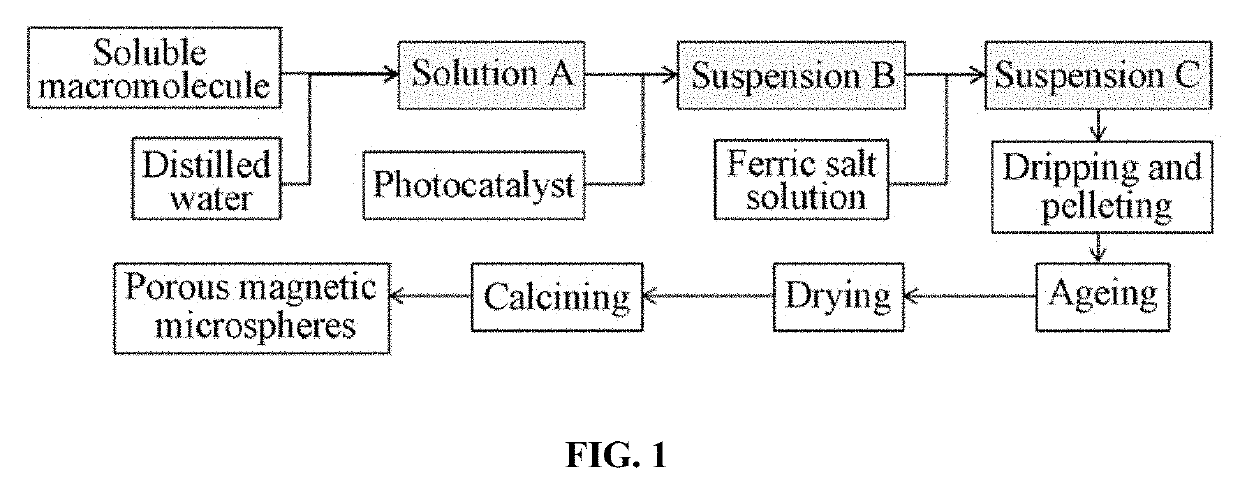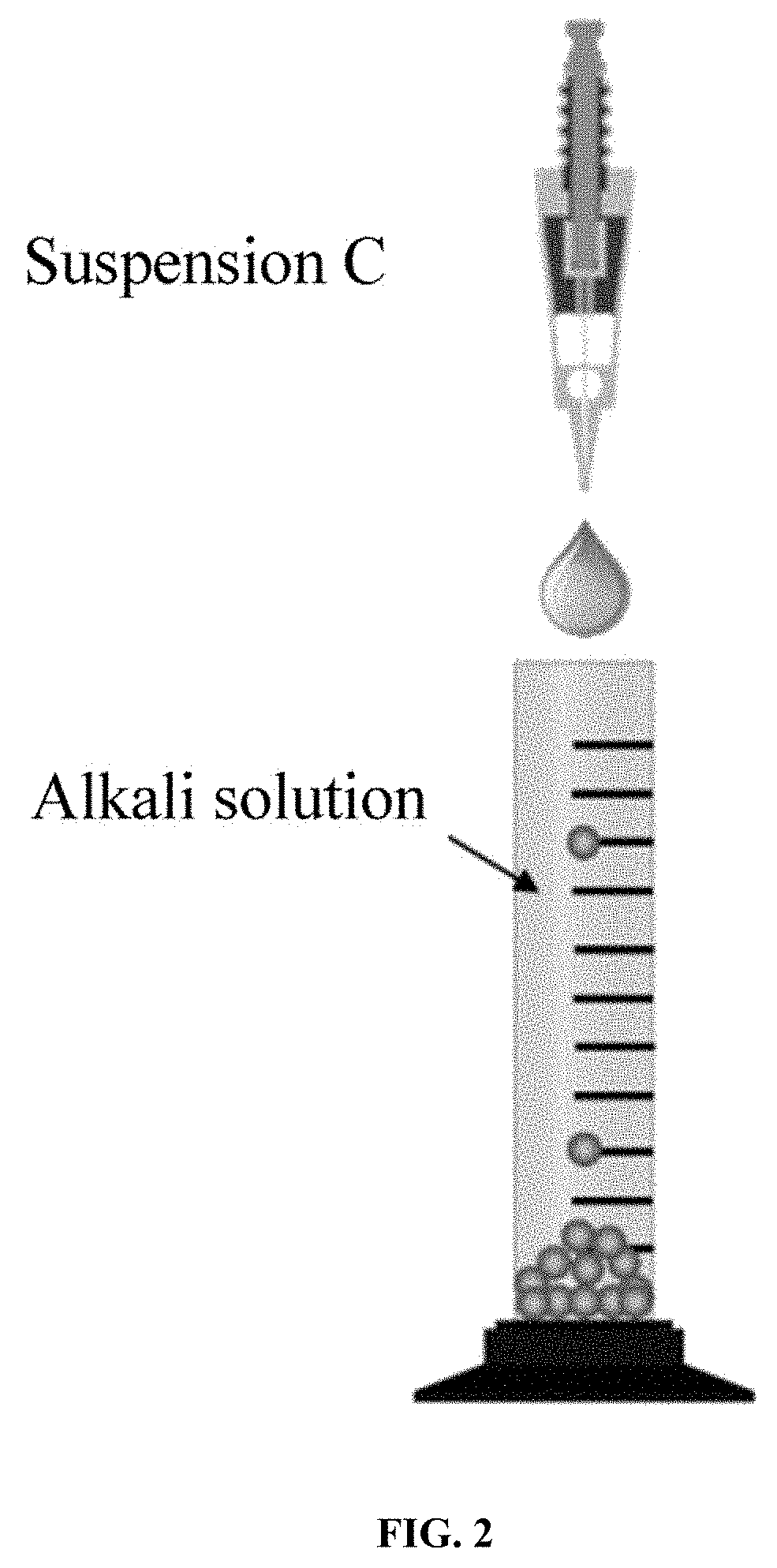Method of preparing large-size high-porosity fe-doped photocatalytic porous magnetic microspheres and uses thereof
a magnetic microsphere and high-porosity technology, applied in the field of preparation of materials, can solve the problems of poor catalytic activity of catalyst, difficult to effectively separate photocatalytic materials from the reaction system by traditional separation methods such as centrifugation and filtration, and achieve the effects of improving the catalytic performance of catalyst, simple process and efficient recovery of catalys
- Summary
- Abstract
- Description
- Claims
- Application Information
AI Technical Summary
Benefits of technology
Problems solved by technology
Method used
Image
Examples
example 1
[0036]In the present embodiment, a method of preparing large-size high-porosity Fe-doped photocatalytic porous magnetic microspheres includes the following steps.
[0037](1) sesbania powder (0.5 g) was dissolved in 100 mL of distilled water to obtain a solution A with a concentration of 0.5 wt %.
[0038](2) titanium dioxide (TiO2, 35 g, 0.438 mol, molecular weight: 79.87) photocatalyst (abbreviated as P-25 below) was added to the solution A, and uniformly mixing under stirring to obtain a suspension B with a solid content of 35 wt %.
[0039](3) saturated FeCl3 solution (11.5 mL, concentration: 92 g / 100 mL) was uniformly mixed with the suspension B in step (2) under stirring to obtain a suspension C. The molar ratio of the Fe3+ ions and the titanium dioxide was 15:100.
[0040](4) The suspension C was dropwise added to a concentrated ammonia water by a syringe equipped with a No. 6-sized needle to form microspheres. The microspheres were aged for 60 minutes and dried at 80° C.
[0041](5) The mi...
application example 1
[0043]The Fe-doped titanium dioxide photocatalytic porous magnetic microspheres of the present embodiment are used for catalytic degradation of an organic dye which is a methylene blue dye. The test method of photocatalytic performance is as follows. Methylene blue solution(100 mL, 50 mg / L) was placed in a beaker. The porous microspheres (50 mg) of the present embodiment was added to the beaker under stirring in a reactor box for 30 minutes without turning on a mercury lamp to achieve an adsorption-desorption equilibrium. Then the mercury lamp (500 W) source was turned on to irradiate the solution. A supernatant was extracted after centrifuging in a sampling interval time of 10 minutes. An absorbance of the methylene blue solution at 664 nm (maximum absorption wavelength) after photocatalytic reaction was measured by an ultraviolet-visible spectrophotometer. Finally, concentrations of the methylene blue solution at each time point were calculated according to the obtained data. The ...
example 2
[0046]In the present embodiment, a method of preparing large-size high-porosity Fe-doped photocatalytic porous magnetic microspheres includes the following steps.
[0047](1) carboxymethylcellulose (0.5 g) was dissolved in 100 mL of distilled water to obtain a solution A with a concentration of 1.5 wt %.
[0048](2) lanthanum potassium titanate (K2La2Ti3O10, 65 g, 0.1 mol, molecular weight: 659.5) photocatalyst was added to the solution A, and uniformly mixing under stirring to obtain a suspension B with a solid content of 65 wt %.
[0049](3) saturated FeCl3 solution (8 mL, concentration: 92 g / 100 mL) was uniformly mixed with the suspension B in step (2) under stirring to obtain a suspension C. The molar ratio of the Fe3+ ions and the lanthanum potassium titanate was 45:100.
[0050](4) The suspension C was dropwise added to a saturated urea solution by a syringe equipped with a No. 4-sized needle to form microspheres. The microspheres were aged for 90 minutes and dried at 60° C.
[0051](5) The ...
PUM
| Property | Measurement | Unit |
|---|---|---|
| temperature | aaaaa | aaaaa |
| concentration | aaaaa | aaaaa |
| absorption wavelength | aaaaa | aaaaa |
Abstract
Description
Claims
Application Information
 Login to View More
Login to View More - R&D
- Intellectual Property
- Life Sciences
- Materials
- Tech Scout
- Unparalleled Data Quality
- Higher Quality Content
- 60% Fewer Hallucinations
Browse by: Latest US Patents, China's latest patents, Technical Efficacy Thesaurus, Application Domain, Technology Topic, Popular Technical Reports.
© 2025 PatSnap. All rights reserved.Legal|Privacy policy|Modern Slavery Act Transparency Statement|Sitemap|About US| Contact US: help@patsnap.com



